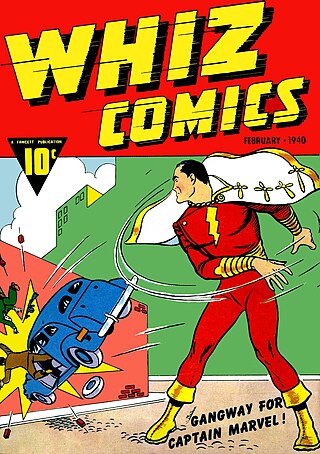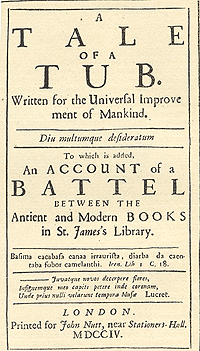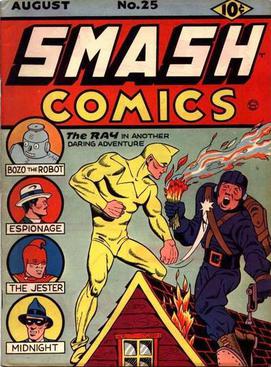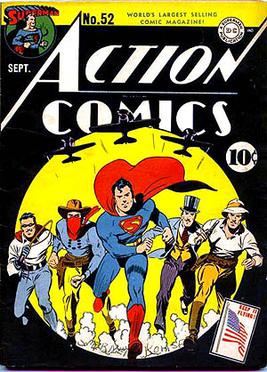
A superhero or superheroine is a stock character that typically possesses superpowers, abilities beyond those of ordinary people, and fits the role of the hero, typically using their powers to help the world become a better place, or dedicating themselves to protecting the public and fighting crime. Superhero fiction is the genre of fiction that is centered on such characters, especially, since the 1930s, in American comic books, as well as in Japanese media.

A Tale of a Tub was the first major work written by Jonathan Swift, composed between 1694 and 1697 and published in 1704. It is arguably his most difficult satire, yet considered by some to be his best. The Tale is a prose parody divided into sections of "digression" and a "tale" of three brothers, each representing one of the main branches of western Christianity. A satire on the Roman Catholic and Anglican churches and English Dissenters, it was famously attacked for its profanity and irreligion, starting with William Wotton, who wrote that it made a game of "God and Religion, Truth and Moral Honesty, Learning and Industry" to show "at the bottom [the author's] contemptible Opinion of every Thing which is called Christianity." The work continued to be regarded as an attack on religion well into the nineteenth century. One commentator complained that Swift must be "a compulsive cruiser of Dunghils … Ditches, and Common-Shores with a great Affectation [sic] for every thing that is nasty. When he spies any Objects that another Person would avoid looking on, that he Embraces.”
Power Girl, also known as Kara Zor-L, Karen Starr, is a superheroine appearing in American comic books by DC Comics, making her first appearance in All Star Comics #58. Power Girl is the cousin of the superhero Superman, but from an alternate universe in the fictional multiverse in which DC Comics stories are set. Originally hailing from the world of Earth-Two, first envisioned as the home of DC's wartime heroes as published in 1940s comic books, Power Girl becomes stranded in the main universe where DC stories are set, and becomes acquainted with that world's Superman and her own counterpart, Supergirl.

Young Justice is a fictional DC Comics superhero team consisting of teenaged heroes.

Bat-Mite is a fictional character appearing in American comic books published by DC Comics. Bat-Mite is an imp similar to the Superman villain Mister Mxyzptlk. Depicted as a small, childlike man in an ill-fitting Batman costume, Bat-Mite possesses what appear to be near-infinite magical powers, but he actually uses highly advanced technology from the fifth dimension that cannot be understood by humans' limited three-dimensional views. Unlike Mxyzptlk, Bat-Mite idolizes his superhero target and thus he has visited Batman on various occasions, often setting up strange and ridiculous events so that he could see his hero in action. Bat-Mite is more of a nuisance than a supervillain, and often departs of his own accord upon realizing that he has angered his idol.
Miss America is a superheroine from the DC Comics Universe. She was first created by Quality Comics in Military Comics #1, and was carried over to DC Comics when they purchased Quality in the 1950s. While the original Golden Age character is in public domain, the subsequent versions created by DC Comics are not.
Bucky is the name used by several different fictional characters appearing in American comic books published by Marvel Comics, usually as a sidekick to Captain America. The original version was created by Joe Simon and Jack Kirby and first appeared in Captain America Comics #1, which was published by Marvel's predecessor, Timely Comics. Following the apparent death of the hero James "Bucky" Barnes, the Bucky nickname and costume have been used by various heroes including: Fred Davis, Jack Monroe, Rick Jones, Lemar Hoskins, and Rikki Barnes. For a time, a child looked after by Jack Monroe was named "Bucky," but she was later adopted and given the name Julia Winters.

The Inferior Five are a parody superhero team appearing in books by the American publisher DC Comics. Created by writer E. Nelson Bridwell and artist Joe Orlando, the team premiered in the DC Comics title Showcase #62.

Bumblebee is a superheroine appearing in American comic books published by DC Comics and other related media, commonly as a member of the Teen Titans. She first appeared as Karen in December 1976's Teen Titans #45, and adopted the Bumblebee identity three issues later. Historically, Bumblebee is sometimes considered DC Comics' first Black woman superhero character, though this distinction is also accorded to Nubia, a less traditional costumed crimefighter than Bumblebee, who debuted several years earlier in 1973.
"$pringfield ", simply known as "$pringfield", is the tenth episode of the fifth season of the American animated television series The Simpsons, and the 91st episode overall. It originally aired on the Fox network in the United States on December 16, 1993. In the episode, Springfield legalizes gambling to revitalize its economy. Mr. Burns opens a casino where Homer is hired as a blackjack dealer. Marge develops a gambling addiction, Bart opens a casino in his treehouse, and Burns' appearance and mental state deteriorate in a parody of Howard Hughes.

Drapier's Letters is the collective name for a series of seven pamphlets written between 1724 and 1725 by the Dean of St Patrick's Cathedral in Dublin, Jonathan Swift, to arouse public opinion in Ireland against the imposition of a privately minted copper coinage that Swift believed to be of inferior quality. William Wood was granted letters patent to mint the coin, and Swift saw the licensing of the patent as corrupt. In response, Swift represented Ireland as constitutionally and financially independent of Britain in the Drapier's Letters. Since the subject was politically sensitive, Swift wrote under the pseudonym M. B., Drapier, to hide from retaliation.

The Ray is the name of four superheroes in the DC Comics Universe. All versions of the character have the superpower of manipulating visible light in some manner.

Hawkeye is a fictional character appearing in American comic books published by Marvel Comics. Created by writer Allan Heinberg and artist Jim Cheung, Bishop first appeared in Young Avengers #1. She is the third character and first female to take the Hawkeye name, after Clint Barton of the Avengers and Wyatt McDonald of the Squadron Supreme. Her costume appearance is patterned on the first Hawkeye and Mockingbird.

Paladin is a fictional character, a mercenary appearing in American comic books published by Marvel Comics. Though not a supervillain, his mercenary activities often bring him into conflict with superheroes.

Disney Princess, also called the Princess Line, is a media franchise and toy line owned by the Walt Disney Company. Created by Disney Consumer Products chairman Andy Mooney, the franchise features a lineup of female protagonists who have appeared in various Disney franchises.

SuperPatriot is an Image Comics superhero created by Erik Larsen in 1992. He regularly appears in Erik Larsen's titles, whether in his own mini-series or as a supporting character and is currently a member of the Liberty League.

Harry "Tex" Thompson is a superhero owned by DC Comics who later became the masked crime-fighter Mr. America and then became an espionage operative called Americommando. He was often aided by his best friend Bob Daley, who for a brief time operated as his costumed sidekick "Fatman". Created by Ken Fitch and Bernard Baily, Tex debuted in Action Comics #1, the same comic that introduced Superman. During his original stories of the 1940s, several of his enemies were based on Yellow Peril stereotypes. Several of his earliest stories featured Gargantua T. Potts, a character based around minstrel show stereotypes about African-Americans.

The Tragedy of Tragedies, also known as The Tragedy of Tragedies; or, The Life and Death of Tom Thumb the Great, is a play by Henry Fielding. It is an expanded and reworked version of one of his earlier plays, Tom Thumb, and tells the story of a character who is small in stature and status, yet is granted the hand of a princess in marriage; the infuriated queen and another member of the court subsequently attempt to destroy the marriage.















